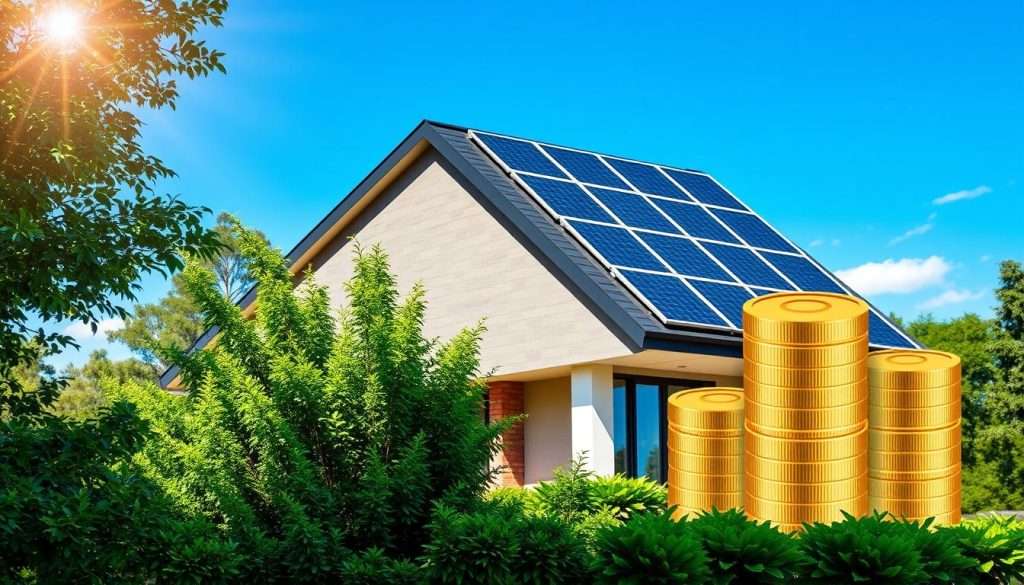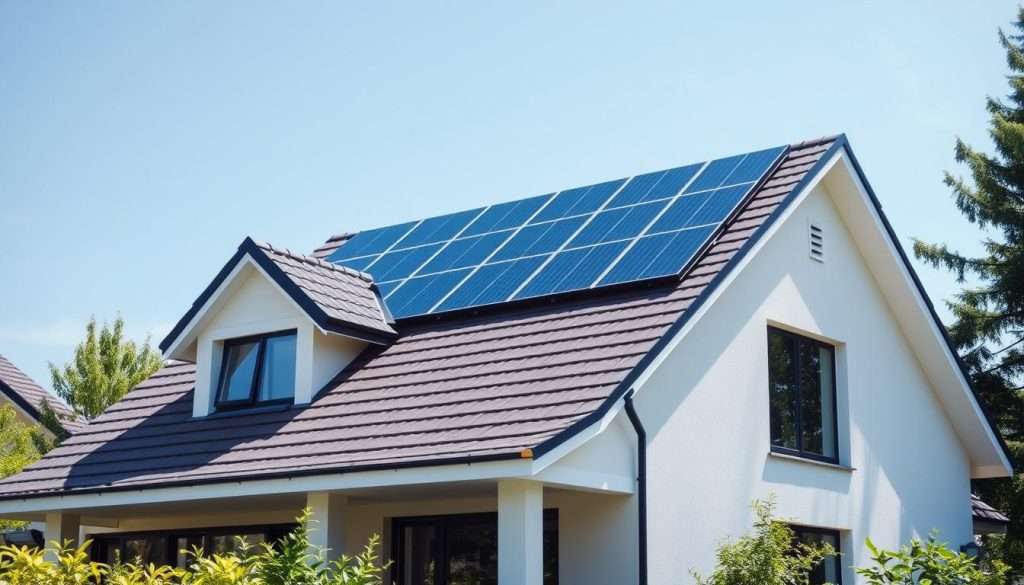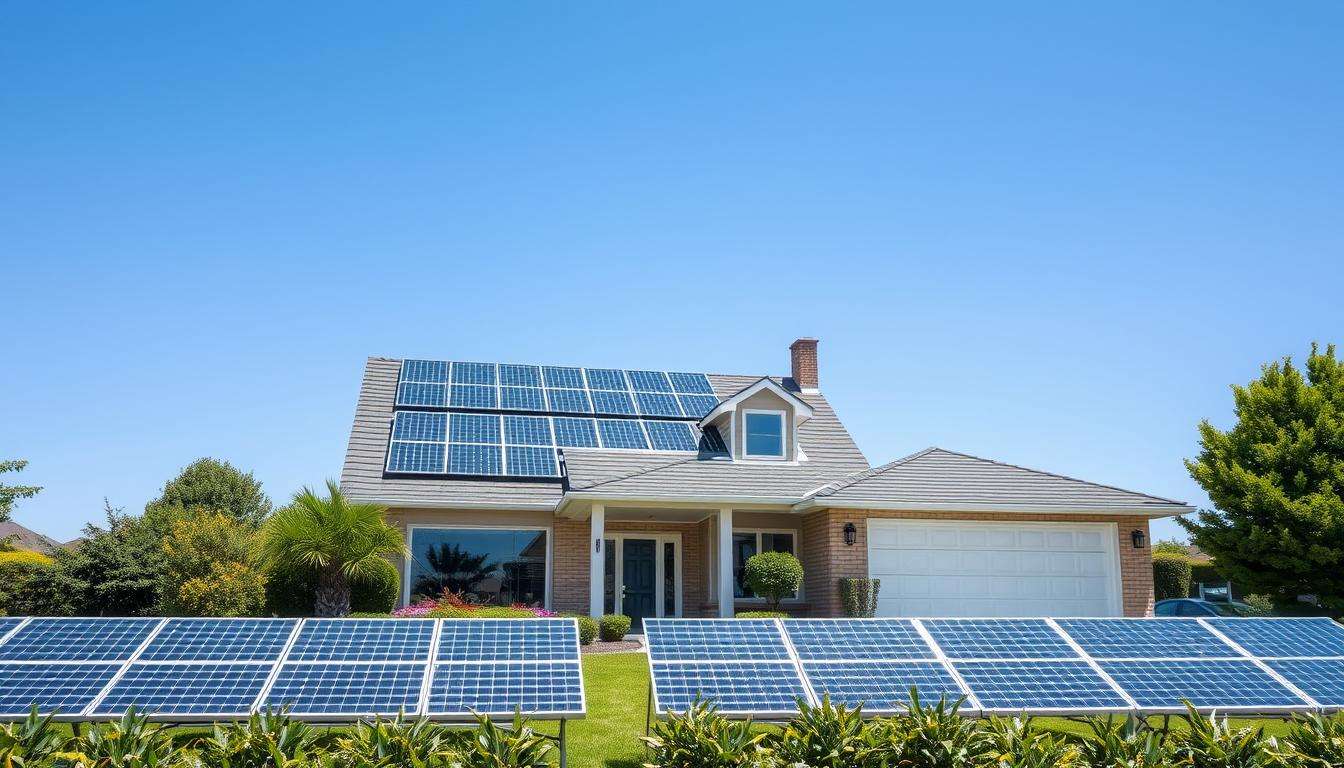Thinking about a new roof? It’s key to know how it fits with energy tax credits. Yes, a new roof can get energy-efficient roof tax credits. But, only if it meets the IRS’s energy standards.
Regular roofing materials don’t qualify for these credits. But, special solar roofing tiles and shingles might. They collect energy and are also part of the roof’s structure.
These tax credits can help make energy-efficient upgrades cheaper. For example, homeowners might save up to 30% with the residential energy-efficient property credit. This depends on when the new roof was installed.
When planning a new roof, knowing about the IRS’s energy tax credit rules is important. It can really help your budget.
Understanding the Energy Tax Credit
Energy tax credits help homeowners save money on taxes. They encourage using renewable energy and energy-saving products. Homes can get federal tax credits for things like solar panels and energy-efficient roofs.
Overview of Energy Tax Credits
There are two main types of energy tax credits for homeowners. The renewable energy tax credit is for green energy systems. Energy efficiency credits are for making homes more energy-smart, like with new roofs and windows.
Types of Tax Credits Available
Homeowners can get different credits for energy-saving upgrades:
- Energy-Efficient Roof Tax Credit: Gives up to 10% back on certain roofing costs.
- Renewable Energy Tax Credit for Roofing: Covers solar roofing materials like solar tiles.
- Green Roof Tax Credit Eligibility: Varies by state but focuses on eco-friendly roofs.
- Federal Tax Credit for Eco-Friendly Roofing: Part of the Energy Efficient Home Improvement Credit, up to $1,200 per year until 2033.
Knowing the rules for these credits is key. Homeowners can lower their taxes with these incentives. Talking to a roofing expert can help understand the rules and how to qualify.
| Type of Credit | Coverage | Credit Amount |
|---|---|---|
| Energy-Efficient Roof Tax Credit | Qualifying roofing materials | Up to 10% of costs |
| Renewable Energy Tax Credit for Roofing | Solar Roofing Tiles | Varies; includes a percentage of installation |
| Green Roof Tax Credit | Eco-friendly roofing systems | State-dependent, often a percentage of costs |
| Federal Tax Credit for Eco-Friendly Roofing | Energy-efficient upgrades | Up to $1,200 per year |
Eligibility Criteria for Solar Roofs
To get the tax credit for solar roofs, homeowners need to follow certain rules. Knowing these rules helps make sure your investment gets the tax benefits it deserves.
Requirements for Solar Panels
For the IRS energy tax credit, solar panels must be made of approved materials. Roofing materials like solar tiles or shingles are okay. They must also meet federal energy standards to get the tax credit.
Before buying solar products, check their certifications and the manufacturer’s details. This ensures your roofing materials are eligible for the energy-saving roof tax deduction. The system must be new and used for the first time to qualify for the credit.
Tax Benefits for Integrated Solar Roofs
Homeowners love the idea of solar roofs because they offer both protection and renewable energy. From 2022 to 2032, you can get up to 30% of the costs back as a tax credit.
But, the tax credit will go down over time. It will be 26% in 2033 and 22% in 2034. So, it’s important to stay updated on these changes. For more info on tax rules, check out this essential resource.

How Energy-Efficient Roofs Impact Tax Credits
Knowing about roofing materials and tax credits is key for home upgrades. You can get a tax credit for an energy-efficient roof. This happens when you pick the right materials that meet IRS rules.
Materials that Qualify
Choose roofing that saves energy and meets quality standards. Here are some good choices:
- Metal roofing
- Asphalt shingles with Energy Star certification
- Tiles that offer high thermal performance
These materials help lower your energy use. They also qualify for a big tax credit for roof replacement. You could get up to $3,200 a year, helping with installation costs.
Installation Standards
It’s important to install these materials right to get tax credits. Follow these steps:
- Use certified installers who know about energy efficiency.
- Make sure the installation meets IRS rules.
- Keep records of energy efficiency.
Good installation protects your money and gets you tax credits. By choosing the right materials and installing them well, you can save a lot on your renovation.
The Application Process for Tax Credits
Getting the IRS energy tax credit for a new roof is easy if you know how. Keep your records in order and you’ll do great. This guide will help you file your taxes and what documents you need.
Filing Taxes with Energy Credits
To claim your energy-efficient roof tax credit, start with IRS Form 5695. This form helps you figure out how much credit you can get. Remember, only count the cost of the materials, not the labor or installation.
Fill out the form right to get the most credit. Each year, there are tax credits for energy-efficient homes. Learn about the green roof tax credit eligibility to get the most help.
Documentation Needed for Claims
Good records are key to claiming tax credits for your roof. Keep these:
- Purchase receipts for roofing materials
- Specifications of energy-efficient products from manufacturers
- The Manufacturer’s Certification Statement, confirming energy efficiency standards
Without these, claiming credits can be tough. Organized records save time and stress. Good records are the heart of claiming your energy-efficient roof tax credit.

| Documentation Type | Description |
|---|---|
| Purchase Receipts | Evidence of costs associated with roofing materials. |
| Product Specifications | Details confirming compliance with energy efficiency standards. |
| Manufacturer’s Certification Statement | Documents from the manufacturer verifying energy-efficient installation. |
With the right info and good records, claiming credits is easy. Use this chance to make your home better and save money!
Common Misconceptions About Roof Tax Credits
Tax credits can be tricky to understand. Many think any new roof gets a tax credit. But, only certain roofs meet IRS rules. This is key for homeowners to get tax breaks.
Some also wonder if labor costs count. This can confuse people when filing taxes.
Myths vs. Facts
It’s important to know the truth:
- Myth: Any new roof qualifies for tax credits.
- Fact: Only certain energy-efficient roofs get the tax deduction.
- Myth: Labor costs are eligible for the credit.
- Fact: Usually, labor costs don’t count for the energy-efficient roof tax credit.
Clarifying Eligibility Requirements
Homeowners need to know what qualifies for tax credits. Not all renovations qualify. There are rules for:
- The type of roofing materials used.
- The energy efficiency ratings they meet.
Knowing these rules helps make better choices. This can lead to bigger tax savings. The IRS says solar tiles or shingles might qualify, but not regular roofs. Doing your homework can help you get more credits.
| Criteria | Eligible | Not Eligible |
|---|---|---|
| New Roof Installation | Specific energy-efficient roofs | Traditional roofs |
| Labor Costs | — | Included in most cases |
| Roofing Materials | Solar shingles | Conventional roofing materials |
| Tax Filing | Eligible expenses for installed solar panels | Expenses unrelated to solar installation |
Benefits of Upgrading to Energy-Efficient Roofing
Getting an energy-efficient roof makes your home look better. It also saves you money on energy bills and taxes. You can get a tax credit for using Energy Star materials.
This credit helps you save money. Plus, you’ll use less energy because of better insulation. The Inflation Reduction Act has made these tax credits even better.
Long-Term Savings on Taxes and Energy Bills
Changing your roof can cut down on heating and cooling costs. This means you’ll save money over time. Insulated roofs, like reflective ones, use less energy.
Homeowners can get up to 30% of their costs back through tax credits. This makes your roof upgrade more affordable. It’s good for the planet and your wallet.
Environmental Impact and Incentives
Energy-efficient roofs are also good for the environment. They use less fossil fuel and reduce carbon emissions. This helps make our air cleaner.
Choosing roofs like reflective metal can save you money on cooling. It’s also good for the planet. We all help make the future cleaner by making these choices.
